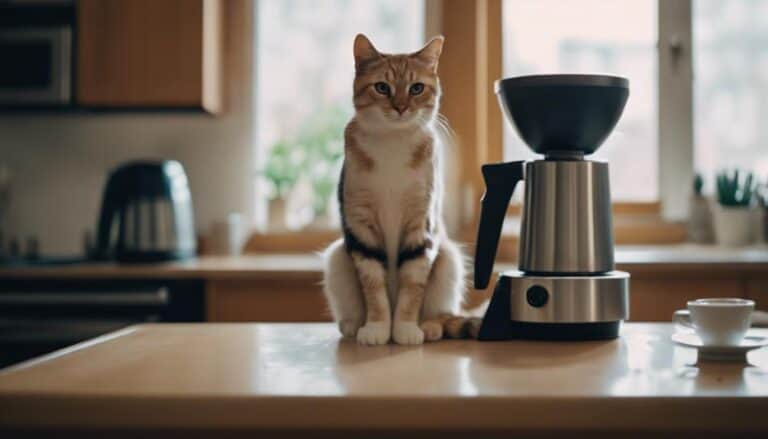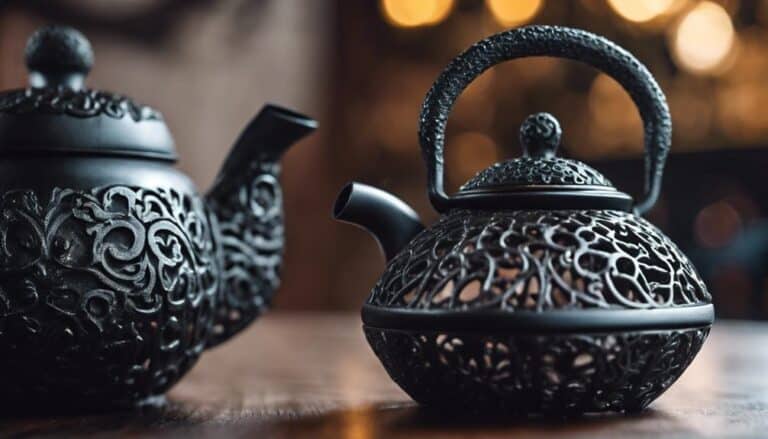Mastering Home Coffee Roasting

Exploring the world of home coffee roasting reveals a domain where precision meets creativity. The journey begins with a single bean and a vision for the perfect cup. As the aroma of freshly roasted coffee fills the room, one can't help but wonder about the endless possibilities that lie ahead. The process of mastering home coffee roasting is not just about brewing a morning pick-me-up; it's about uncovering a passion that transforms the ordinary into the extraordinary.
Fundamentals of Home Coffee Roasting
Delving into the fundamentals of home coffee roasting, one quickly realizes that the key to revealing rich, aromatic flavors lies in mastering the art of time, temperature, and technique. When it comes to coffee roasting, the journey begins with the humble green coffee beans, waiting to reveal their full potential. Each bean carries within it a world of flavors and aromas that, when coaxed out through roasting, can create a symphony for the senses.
Roasting coffee at home is a liberating experience, allowing you to take full control of the process. From the moment the beans hit the roaster to the final crack signaling their readiness, you're the conductor of this flavorful orchestra. The ability to experiment with different roast levels, from a light cinnamon roast to a bold French roast, empowers you to tailor your coffee exactly to your liking.
Through the alchemy of time, temperature, and technique, you can transform raw green beans into a cup of liquid gold that speaks to your soul. Home coffee roasting isn't just a task; it's a journey of self-discovery through the medium of coffee.
Impact of Temperature and Time
Controlling temperature and time during coffee roasting is my passion; it's where the magic happens. The way heat interacts with the beans dictates the flavors that will emerge, from delicate to bold.
Understanding this relationship is crucial to revealing the full potential of your beans and crafting the perfect cup.
Roasting Duration Effects
Exploring the impact of temperature and time on roasting duration reveals the essential dance that shapes the flavors and aromas of freshly roasted coffee beans.
The duration of roasting plays a vital role in determining the final flavor profiles of the coffee. Longer roasting durations at lower temperatures can enhance the sweetness and body of the beans, while shorter durations at higher temperatures may lead to brighter acidity and complex flavors.
The interactions between time and temperature during roasting are pivotal in developing the desired aroma compounds that contribute to the overall sensory experience.
Finding the ideal roasting duration for specific beans is key to achieving the perfect balance between caramelization and acidity, resulting in a delightful cup of coffee tailored to your preferences.
Temperature Variations Impact
Understanding the intricate interplay between temperature variations and time is essential for mastering the art of home coffee roasting.
- Temperature variations impact the chemical reactions responsible for developing the rich flavor compounds in coffee beans.
- Careful management of higher temperatures prevents uneven roasts and guarantees ideal roast times.
- Longer roasting at lower temperatures enhances the coffee's flavor profile, revealing nuanced characteristics.
- Monitoring temperature fluctuations is key to achieving consistent and desired roast levels, allowing for precise control over the roasting process.
Time Vs Flavor Development
When delving into the intricate world of home coffee roasting, the dynamic relationship between time and temperature plays an essential role in shaping the flavor profile of the final brew.
Roasting time and temperature are pivotal factors in flavor development. Longer roasting times at lower temperatures can enhance the sweetness and body of the coffee, while quick roasting at high temperatures can result in brighter acidity and floral notes.
Understanding this balance is key to achieving the desired flavor profiles in your coffee beans. By experimenting with different time-temperature variations in your roasting process, you have the freedom to customize and create unique flavor outcomes that suit your preferences.
Mastering the art of balancing roasting time and temperature is the gateway to accessing a world of rich and diverse coffee flavors.
Choosing the Right Roasting Method
For achieving diverse and complex flavor profiles, one must carefully consider the roasting method chosen for their coffee beans. Each roasting method offers unique characteristics that can greatly impact the final taste of your brew.
Here are some key points to help you select the right roasting method:
- Drum Roasting: Provides even heat distribution, making it ideal for developing complex flavor profiles in the beans.
- Air Roasting: Offers a cleaner flavor profile and guarantees consistent roasts batch after batch.
- Fluid Bed Roasting: Allows for a uniform roast and provides precise control over the roasting process, resulting in a consistent outcome.
- Consider Flavor Outcomes: Select a roasting method based on the desired flavor outcomes you wish to achieve and the specific characteristics of the beans you're working with.
Understanding Coffee Bean Types
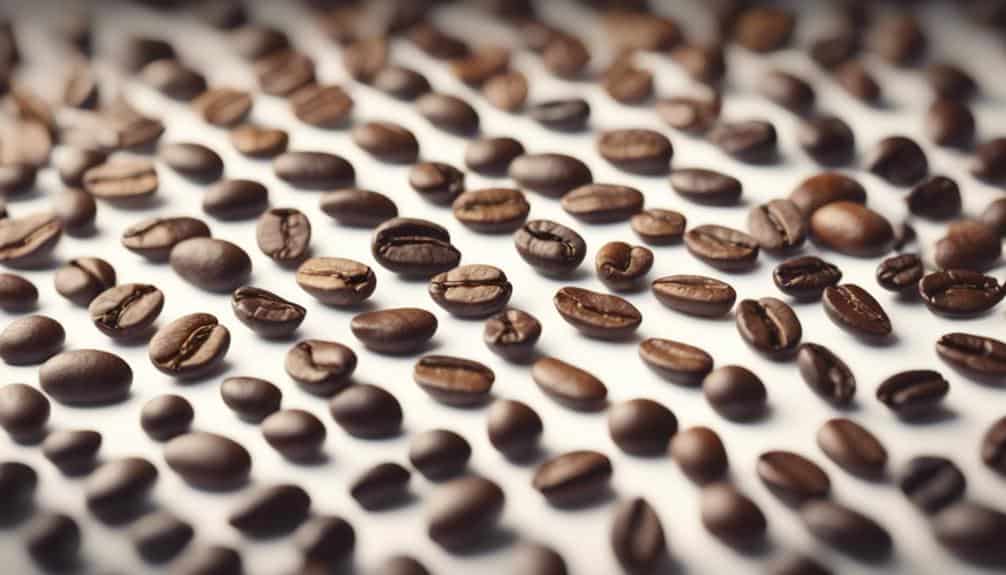
Delving into the intricate world of coffee bean types reveals a rich tapestry of flavors and characteristics waiting to be explored. Arabica beans are renowned for their delicate flavors and aromatic qualities, offering a nuanced and refined coffee experience. On the other hand, Robusta beans are prized for their bold, strong taste and higher caffeine content, providing a robust and intense cup of coffee.
Different bean types thrive in specific regions due to variations in climate and altitude, influencing their flavors and growth patterns. Additionally, the processing method employed, such as washed, natural, or honey, plays an essential role in determining the final flavor profile of the coffee beans. Roasters carefully manipulate various variables during the roasting process to accentuate the unique characteristics of each bean type, ensuring that the innate flavors shine through in every cup brewed.
Understanding the nuances of bean types and processing methods empowers coffee enthusiasts to tailor their roasting approach and create personalized, exceptional brews at home.
Equipment and Process Overview
When it comes to home coffee roasting, understanding the different roasting methods, having the essential equipment, and following a step-by-step roasting process are key to success.
I'll be breaking down the various roasting methods and equipment needed, as well as detailing the essential steps in the roasting process to help you achieve that perfect roast.
Let's explore the world of home coffee roasting together, from equipment essentials to the intricacies of the roasting process.
Roasting Methods Explained
In home coffee roasting, understanding the equipment and process behind different roasting methods is key to achieving exceptional results. When it comes to roasting techniques, two popular methods stand out:
- Drum Roasting: This traditional method involves a rotating drum over a heat source, providing a classic approach to roasting coffee beans.
- Air Roasting: On the other hand, air roasting suspends green beans in hot air, ensuring an even roast with modern precision.
- Equipment Selection: Factors like temperature control and airflow management play an important role in the roasting process.
- Process Understanding: From evaluating green beans to packaging the final product, comprehending each step is essential for home coffee roasters.
Mastering these techniques with quality equipment guarantees consistency and enhances the flavor profile and aroma of your coffee beans.
Essential Equipment Needed
To begin the journey of home coffee roasting, one must first equip themselves with essential tools that form the backbone of the roasting process. A reliable roaster is key, whether it's an air popcorn popper or a drum roaster, offering varying levels of control over the roast.
A thermometer is vital for monitoring the temperature, ensuring precision in achieving the desired roast levels and flavor profiles. Additionally, a timer helps keep track of the roasting process, while a cooling tray is essential for quickly cooling the beans post-roast.
Selecting quality equipment plays a significant role in the consistency and quality of the outcomes in your home coffee roasting adventures.
Step-By-Step Roasting Process
Let's explore the heart of the home coffee roasting process, examining the precise equipment and steps that lead to crafting your perfect roast.
When roasting coffee beans at home, it's essential to have the right tools and follow a methodical approach:
- Choose the appropriate roaster, whether it's an air roaster or drum roaster, to suit your preferences.
- Preheat your roaster to the recommended temperature before adding the green beans.
- Carefully load the green beans into the roaster and monitor the time and temperature throughout the roasting process.
- Understand the different roast levels to achieve the flavor profile you desire for your home coffee.
Experimentation and Recording Results
Starting the adventure of home coffee roasting necessitates careful experimentation and meticulous recording of results to reveal the full potential of flavor development. By adjusting variables like roast time and temperature, one can unveil a myriad of flavors hidden within each coffee bean.
Experimenting with different roasting profiles is key to understanding how they influence flavor development. Utilizing a cupping technique allows for a structured approach to tasting and evaluating the outcomes of each roast, enabling you to pinpoint the nuances in aroma, acidity, body, and aftertaste.
Keeping a detailed log of each roast, including factors like time, temperature, and bean type, provides a valuable reference for future roasting endeavors. Gradually adjusting these variables based on your sensory observations will help fine-tune your preferred roasting profile, leading to a personalized and exceptional cup of coffee tailored to your unique taste preferences.
Experimentation is the gateway to discovering the endless possibilities that home coffee roasting has to offer.
Honing Roasting Techniques
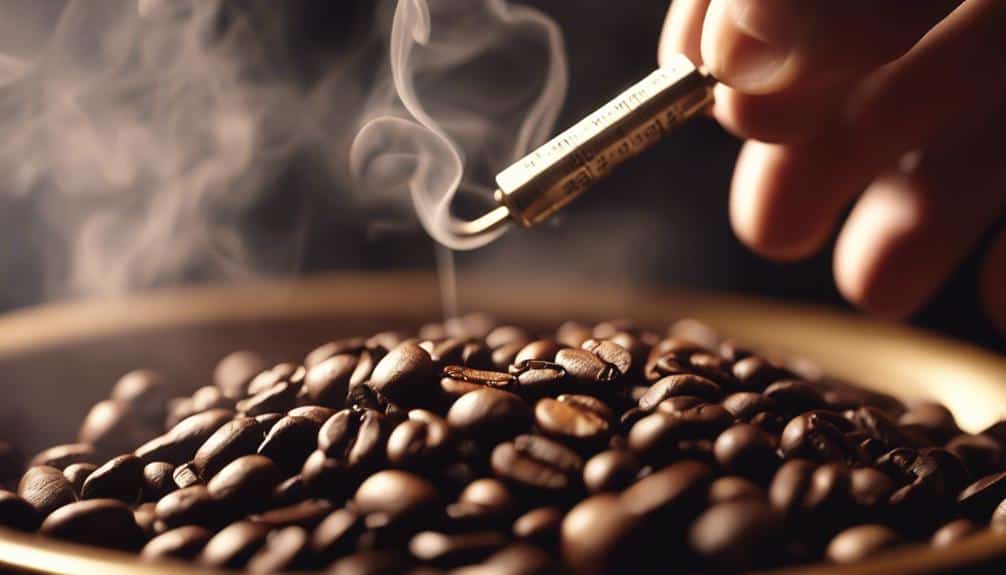
Starting on the journey of honing roasting techniques opens up a world of possibilities to elevate the flavors of home-roasted coffee beans. Mastering the art of roasting is a thrilling experience that allows me to explore the intricacies of flavor development and customization.
Here are some key aspects to focus on when honing roasting techniques:
- Controlling Time and Temperature: Adjusting these variables with precision is vital for achieving specific flavor profiles in each roast.
- Exploring Different Roasting Methods: Experimenting with drum roasting, air roasting, or other techniques can lead to unique and exciting flavor combinations.
- Understanding Roast Levels: Learning to distinguish between light, medium, and dark roasts helps in creating the perfect roast for different beans.
- Customizing Roasts: Tailoring roasting techniques to personal preferences allows for the creation of bespoke coffee blends that suit individual tastes.
Achieving Customized Roasts
Achieving personalized roasts through home coffee roasting opens up a world of flavor exploration and customization. By tinkering with roast levels, I can fine-tune the flavor intensity and aroma of my coffee beans to match my exact preferences. Whether I prefer a light, medium, or dark roast, the ability to control the roasting process lies in my hands. Adjusting time and temperature settings allows me to craft unique and personalized coffee experiences that cater to my individual taste buds.
Understanding the nuances of roast levels is key to revealing the desired flavor characteristics in my beans. This knowledge empowers me to experiment with different profiles, creating a symphony of flavors that tantalize my senses. Home roasting isn't just about making coffee; it's about embarking on a sensory journey where each roast brings me closer to the perfect cup. With each batch I roast, I explore further into the art of coffee roasting, uncovering new aromas and tastes that elevate my coffee experience to new heights.
Rivaling Professional Roasters
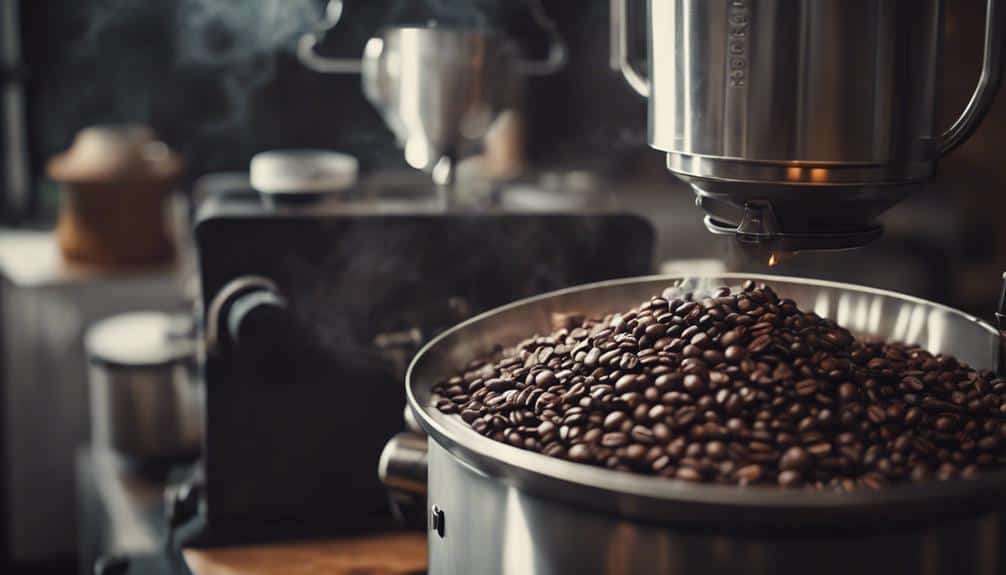
Venturing into the world of home coffee roasting not only grants me the autonomy to customize my brews but also equips me with the skills to rival professional roasters in achieving intricate flavor profiles. By delving into the art of roasting the beans at home, I'm opening up a world of possibilities that allow me to create coffees that rival those of the experts. Here's how I can make it happen:
- Experimenting with different roasting profiles to uncover unique flavor notes.
- Mastering the intricacies of the roasting process to achieve consistent and delicious results.
- Tailoring the roast level to suit my preferences, enabling me to fine-tune the flavor profile.
- Engaging with online communities to gather insights, tips, and tricks for refining my roasting skills.
With dedication and a thirst for knowledge, I can elevate my home roasting game to produce coffees that stand shoulder to shoulder with those crafted by professional roasters.
Conclusion
Mastering home coffee roasting is a thrilling journey of discovery and creativity. By delving into the fundamentals, experimenting with temperature and time, and honing roasting techniques, enthusiasts can craft personalized roasts that rival professional blends.
The ability to control variables, record results, and create unique blends allows for an unparalleled coffee experience that's truly one-of-a-kind. Home roasting opens up a world of possibilities, transforming a simple cup of coffee into a flavorful adventure.

